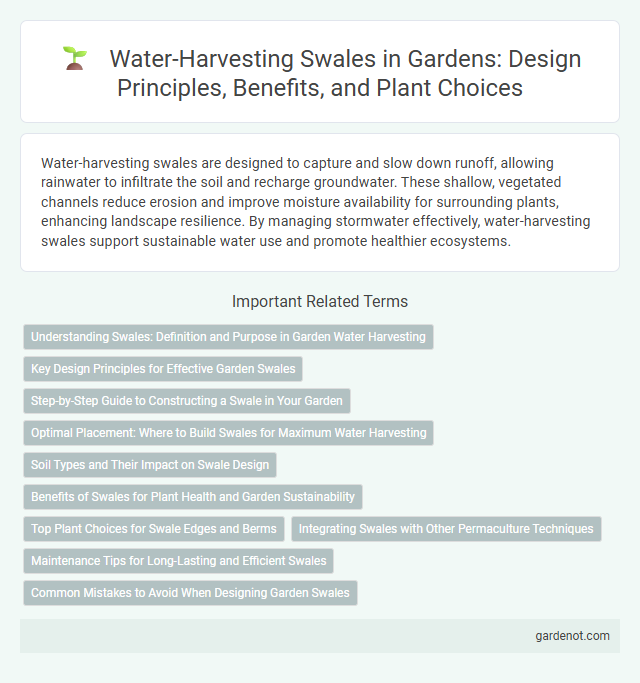Water-harvesting swales are designed to capture and slow down runoff, allowing rainwater to infiltrate the soil and recharge groundwater. These shallow, vegetated channels reduce erosion and improve moisture availability for surrounding plants, enhancing landscape resilience. By managing stormwater effectively, water-harvesting swales support sustainable water use and promote healthier ecosystems.
Understanding Swales: Definition and Purpose in Garden Water Harvesting
A water-harvesting swale is a shallow, vegetated trench designed to capture and infiltrate rainwater, reducing runoff and enhancing soil moisture. Its primary purpose in garden water harvesting is to slow down water flow, allowing it to seep into the ground and support plant growth while preventing erosion. Swales create a sustainable water management system by mimicking natural landscape contours, optimizing rainwater utilization in gardens and landscapes.
Key Design Principles for Effective Garden Swales
Water-harvesting swales are designed to capture and slow runoff, allowing water infiltration and reducing erosion in garden landscapes. Key design principles include precise contour alignment to ensure even water distribution, appropriate sizing based on catchment area metrics, and incorporation of overflow outlets to manage excess flow during heavy rainfall events. Mulching and native vegetation planting within swales enhance soil structure and promote long-term moisture retention for sustainable garden health.
Step-by-Step Guide to Constructing a Swale in Your Garden
Constructing a water-harvesting swale begins with identifying the contour lines in your garden to ensure proper water flow capture. Dig a shallow trench following these contours, then pile the excavated soil on the downhill side to form a berm that slows runoff and enhances infiltration. Plant native, drought-tolerant vegetation along the berm to stabilize soil and promote water absorption, optimizing the swale's efficiency in harvesting rainwater.
Optimal Placement: Where to Build Swales for Maximum Water Harvesting
Optimal placement of water-harvesting swales involves locating them on contour lines or gentle slopes to maximize water infiltration and minimize erosion. Swales positioned in natural drainage pathways capture runoff efficiently, promoting groundwater recharge and reducing surface flow velocity. Selecting sites near vegetation or crop zones enhances soil moisture retention, supporting plant growth and sustainable land management.
Soil Types and Their Impact on Swale Design
Soil types significantly influence the effectiveness of water-harvesting swales by determining infiltration rates and water retention capacity; sandy soils require wider, gentler swales to slow runoff, while clay soils benefit from narrower, deeper designs to enhance absorption without causing waterlogging. Loamy soils offer balanced drainage and moisture retention, making them ideal for standard swale construction. Understanding soil texture, structure, and permeability is critical for optimizing swale dimensions and placement to maximize water harvesting and minimize erosion.
Benefits of Swales for Plant Health and Garden Sustainability
Water-harvesting swales enhance plant health by efficiently capturing and retaining rainwater, reducing soil erosion and promoting deep root growth. These swales improve soil moisture levels, supporting diverse plant species and increasing resilience to drought conditions. Incorporating swales in garden design boosts sustainability by reducing irrigation needs and fostering natural nutrient cycling.
Top Plant Choices for Swale Edges and Berms
Water-harvesting swale edges and berms benefit from drought-tolerant plants like lavender, yarrow, and sedum that stabilize soil and reduce erosion. Deep-rooted species such as native grasses and herbaceous perennials enhance water infiltration and support beneficial microbial activity. Selecting pollinator-friendly plants like coneflowers and milkweed further promotes biodiversity and ecosystem health around swale installations.
Integrating Swales with Other Permaculture Techniques
Water-harvesting swales optimize rainwater infiltration by capturing runoff along contours, reducing erosion and enhancing soil moisture. Integrating swales with techniques like keyline design and mulching maximizes water retention and nutrient distribution across permaculture landscapes. Combining swales with companion planting further improves microclimates, supports biodiversity, and promotes sustainable food production.
Maintenance Tips for Long-Lasting and Efficient Swales
Regular inspection of water-harvesting swales ensures debris and sediment buildup is promptly removed, maintaining optimal water infiltration and flow. Vegetation management, including planting deep-rooted native species, stabilizes swale banks and prevents erosion while enhancing water absorption. Periodic reshaping of swale contours and repairing any signs of erosion or damage preserves structural integrity and maximizes swale longevity.
Common Mistakes to Avoid When Designing Garden Swales
Common mistakes in designing water-harvesting garden swales include incorrect slope gradient that prevents effective water infiltration and causes erosion. Neglecting proper soil assessment can lead to poor water retention and plant health issues. Failing to include overflow structures risks flooding during heavy rainfall, compromising garden stability and functionality.
Water-harvesting swale Infographic

 gardenot.com
gardenot.com